7 Unbelievable Amphibians
Here we present to you our choices for 7 Unbelievable Amphibians, appearing in various locations around the world. The Order of amphibians itself actually contains about 7,000 known species. Of these, however, roughly 90% are either frogs or toads.
These 7 Unbelievable Amphibians, and their related brethren primarily live in either temperate or tropical environments. Many of the various species also play pivotal roles in their respective habitats. Some of the species have evolved rather remarkable traits.
Vietnamese Mossy Frog
Vietnamese Mossy Frog Facts
- The simultaneously descriptive and accurate term of Vietnamese Mossy Frog serves as one of the common names for a remarkable amphibian. It also goes by alternate names, though, including the mossy frog, and Tonkin bug-eyed frog.
- Its official scientific name, however, remains that of the tongue-twisting Theloderma corticale. But by either of these various names, this amazing animal represents yet another masterpiece of evolution in the minds of many people.
- Quite fortunately, this marvel of Nature appears to be maintaining a sufficient and stable population base. This further seems to hold true throughout the entirety of its natural range. Yet, while its numbers appear stable, it nonetheless has a limited range.
- But, despite the limitations this imposes, the IUCN currently list the Vietnamese Mossy Frog as Least Concern. This status appears on the organization’s Red List of Threatened Species. Its situation remains subject to change, however.
- That’s due to the fact that it now faces several threats to its existence. Loss of habitat, due to deforestation, obviously poses a serious danger, along with the international pet trade, regrettably. Its greatest threat, though, likely consists of climate change.
Vietnamese Mossy Frog Physical Description
The incredible Vietnamese Mossy Frog attains its relative fame due to characteristics other than its sheer size. Its most notable feature, as the name itself suggests, is the presence of a dense collection of protuberances and tubercules over most of its body.
The combined effect serves as the source of its most frequently used common name. Its coloring also plays a role in that naming, however. The skin of the creature generally shows a background of green, with various colored spots and markings added to the mix.
Such an astonishing combination of natural factors makes the animal strongly resemble a clump of moss. Given its natural habitat, this provides it with a highly effective degree of natural camouflage. In fact, it’s almost impossible to spot individuals in the wild.
But speaking purely in terms of size, the Vietnamese Mossy Frog remains an average-size amphibian. It further displays a slight degree of sexual dimorphism. Overall, it averages 3.5 in (8.9 cm) in length, with females being slightly larger than the males.
- Kingdom: Animalia
- Phylum: Chordata
- Class: Amphibia
- Order: Anura
- Family: Rhacophoridae
- Genus: Theloderma
- Species: T. corticale
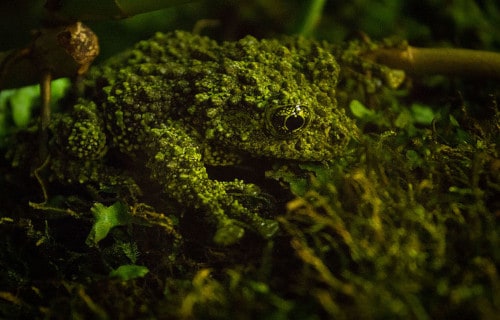
Vietnamese Mossy Frog Distribution, Habitat, and Ecology
Quite sadly for those who appreciate the wonders of Nature, the Vietnamese Mossy Frog only inhabits a small area of the world. More precisely, as the name implies, it mainly exists in the northern portions of the country of Vietnam, in Asia.
Reports of small populations in other regions also exist, though. These other regions include the province of Hainan, in China, and possibly Laos. Wherever the animal makes an appearance, though, it displays decided preferences for its choice of habitat.
Being semi-aquatic in nature, it requires a nearby source of water. But that’s only the beginning. Very specifically, the amphibian has only been seen on the banks of mountain streams, at elevations of approximately 3,000 ft (9.842 ft), or in flooded caves.
This truly fascinating animal evolved, like many of its brethren, as nocturnal in nature. It’s also fully insectivorous in its dietary habits. The frog primarily consumes larger insects, such as crickets, cockroaches, and moths, but will feed opportunistically.
The breeding patterns of the Vietnamese Mossy Frog also seems to be quite specific. This mainly takes place in partially flooded rock cavities. The female typically lays a clutch of 8 – 10 eggs, placed above the water. These generally hatch over a period of 7 – 14 days.
After hatching, the newborn instinctively quickly drop into the water below them. The ensuing metamorphosis from tadpole into frog typically requires around 3 months. The exact lifespan in the wild remains unknown, but estimates place it at 10 years.
Chinese Giant Salamander
Chinese Giant Salamander Facts
- Thnext creatue appearing on this list of 7 Unbelievable Amphibians goes by wholly appropriate, as well as descriptive, name of the Chinese Giant Salamander.
- This astonishing work of Nature and evolution bears the informative, as well as accurate, common name for good reasons. It also bears another, more difficult to pronounce name. That’s because it holds the scientific name of the Andrias davidianus.
- It owes this term to the highly respected French zoologist and entomologist Charles Émile Blanchard. This researcher made the first known formal recognition of it as a separate and distinct species. This scientifically notable event occurred in 1871.
- For the moment, however, it also serves as the focus of ongoing and scientific debate. That’s due to recent DNA research. A 2018 study revealed that several subspecies of the remarkable creature may in fact exist. This would complicate its classification.
- It holds several distinctions in the annals of science, in fact. The first’s a positive one, of sorts. That’s because it’s presently the largest of all known amphibians. The second, however, isn’t as fortunate. It also remains among the most threatened.
- Therefore, the IUCN lists it on the organizations’ Red List of Threatened Species. On that list, it holds the regrettable status of Critically Endangered. It currently faces several threats to its existence, including habitat loss and human consumption.
- Unfortunately, but not surprisingly, it also faces one more danger. The Chinese Giant Salamander now finds itself facing yet another factor augmenting these perils. That, of course, is the ever increasing concern of the ongoing effects of climate change.
Chinese Giant Salamander Physical Description
The most readily noticeable aspect of the aptly-named Chinese Giant Salamander has to be its sheer size. It easily earns its spot as the largest of all known amphibians. Unlike some of its kin, though, this generally species displays no noticeable degree of sexual dimorphism.
The lone known exception to this somewhat uncommon fact occurs during mating season. That’s because, at that time, certain glands of the males swell temporarily. With that sole exception, the two genders remain virtually indistinguishable to the naked eye.
Specimens of both sexes, more precisely, frequently grow to relatively enormous sizes, as the name implies. A mature individual attains an average length of roughly 3.8 ft (1.16 m). These same specimens average a body weight of about 55 – 66 lb (24.9 – 29.9 kg).
Exceptional specimens do often occur, however. In point of fact, some attain lengths of as much as 5.9 ft (1.8 m). The weight of these same creatures sometimes equals a much as 130 lb (59 kg). The Chinese Giant Salamander clearly earns its common name.
Its also has a startling, wrinkly appearance. In color, it usually presents a dark brown, with a speckled or mottled pattern present. Some, though, can be dark brown, reddish, or even black. The creature further has a large head, wide mouth, and small, lidless eyes.
- Kingdom: Animalia
- Phylum: Chordata
- Class: Amphibia
- Order: Urodela
- Family: Cryptobranchidae
- Genus: Andrias
- Species: A. davidianus
Chinese Giant Salamander Distribution, Habitat, and Ecology
The very name of the awesome Chinese Giant Salamander obviously provides a clue to its native range. The magnificent creature lives only in the portion of Asia that now forms the country of China. Even there, though, its locality remains somewhat limited.
Previously, the wonder of Nature seemed to be widespread throughout southern, southwest, and central China. Now, however, that range appears to be highly broken. The known populations appear from Qinghai to Jiangsu, to Guangxi, Guangdong, and Sichuan.
The greatest known concentrations further appear within three large river basin regions in the area. These consist of the Pearl River, the Yellow River, and the Yangtze. Yet another small population of these giant amphibians potentially exists in the Tibetan Plateau.
It also seems to have a preference for certain altitudes, where its choice of habitat is concerned. That’s due to the fact that most specimens appear at altitudes between 300 – 4,900 ft (100 – 1,500 m). One exception, though, is a grouping living at 13,800 ft (4,200 m).
This remarkable animal evolved as entirely aquatic in nature. Individuals mainly live in lakes with clear water, and rocky streams in the hills. In these locations, most make their home along the banks, typically in regions where dark, rocky crevices line those banks.
The Chinese Giant Salamander, like most of its kind, evolved as a carnivore. Its known prey consists of various local species. These include millipedes, insects, freshwater crabs, fish, and even small shrews. This natural wonder itself has no known natural predators.
Wood Frog
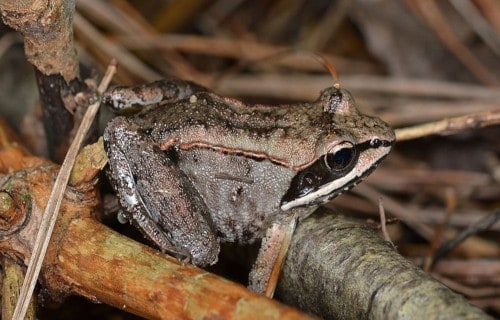
Wood Frog Facts
- Due to its remarkable evolutionary adaptations, the Wood Frog has attracted great interest from researchers in recent years.
- The frog has evolved a method of surviving being partially frozen in winter. It has developed special chemical reactions in its body that allow this.
- This process prevents the total freezing of the water in its cells and bloodstream.
- As long as no more than 65% of the water in its body freezes, it survives. This alone qualifes it as one of our 7 Unbelievable Amphibians.
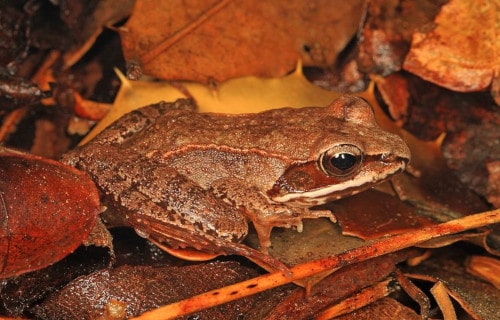
Wood Frog Physical Description
The fascinating Wood Frog may range in length from about 2-2.8 in (0.8-1.1 cm). The species also exhibits a slight degree of sexual dimorphism. Females grow somewhat larger in size than the males.
The adult typically appears dark brown or varying shades of tan on their upper body. The underside is generally a pale green or yellow.
This animal also possesses the ability to alter its coloring at will as well, within the aforementioned range of colors.
Any small brownish colored frog seen in the forest is most likely a member of this species. It remains the only known species in its range with this physical appearance.
Kingdom: Animalia
Phylum: Chordata
Class: Amphibia
Order: Anura
Family: Ranidae
Genus: Lithobates
Species: L. sylvaticus
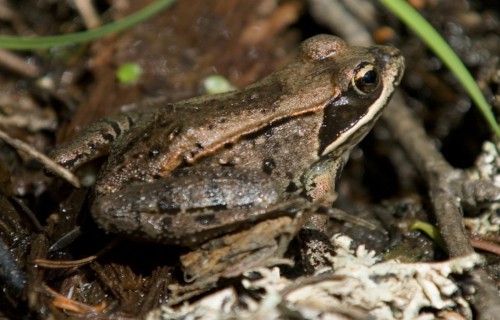
Wood Frog Distribution, Habitat, and Ecology
The amazing Wood Frog evolved as endemic to a broad range of North America extending from the southern Appalachian Mountains all the way to Alaska.
The species is almost exclusively forest-dwelling by nature. It also primarily breeds in woodland vernal pools and freshwater wetlands. When not breeding, individuals may be in or near moist ravines, upland habitats, or freshwater swamps.
The adult Wood Frog will spend the summer and spring in these ravines, bogs, woodlands, or forested swamps. During the fall it will migrate to neighboring uplands.
This is where the majority of this species will live out the winter season. It primarily inhabits the upper layer of soil, just beneath layers of leaves.
The amphibian is principally diurnal and rarely emerges at night unless disturbed.
Indian Bullfrog
Indian Bullfrog Facts
- Look at the brilliantly contrasting colors of the Indian Bullfrog. It doesn’t look like it could be real, does it? This gorgeous fellow represents a relatively large and colorful species of a bullfrog.
- This unique animal remains endemic to many parts of It also now seems to be introduced into Madagascar, where people consider it an invasive species.
- This animal actually gets commercially farmed in Thailand. The Indian Bullfrog holds the classification of a species of Least Concern with the IUCN, due to its widespread habitat range, and large population.
- However, this seems likely to change, given (to no great surprise) the rapid degree of habitat loss due to human expansion in its native range.
Indian Bullfrog Physical Description
The extremely large Indian Bullfrog attains a body length of as much as 6.5 in (16.5 cm).
Its snout grows comparatively pointed in shape. The species is primarily a combination of dark yellow and olive green in color. Individuals also display random darker patches.
However, the male Indian Bullfrog will change its colors to primarily bright yellow during mating season, to attract females. The large bright blue sacs under its jaw also serve to also attract females.
The toes of this particular variety of frog remain almost completely webbed.
Kingdom: Animalia
Phylum: Chordata
Class: Amphibia
Order: Anura
Family: Dicroglossidae
Genus: Hoplobatrachus
Species: H. tigeriuns
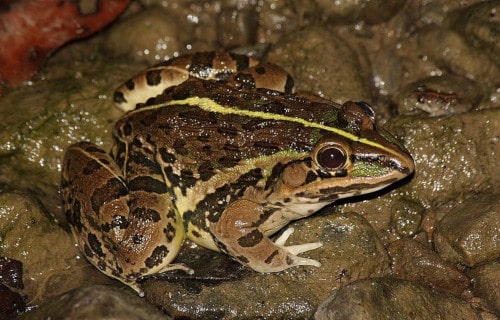
Indian Bullfrog Distribution, Habitat, and Ecology
The Indian Bullfrog is endemic to a wide swathe of Asia. It typically inhabits regions of freshwater wetlands, including man-made paddy fields.
Individuals most commonly inhabit bushes and holes near water.
This amphibian is carnivorous in nature. Given its size, the species primarily prey on small mammals, invertebrates, and even small birds.
This bullfrog is also principally nocturnal in behavior. The species breeds during the regional monsoon season.
The female lays great numbers of eggs. However, the mortality rate among tadpoles is high.
Purple Frog
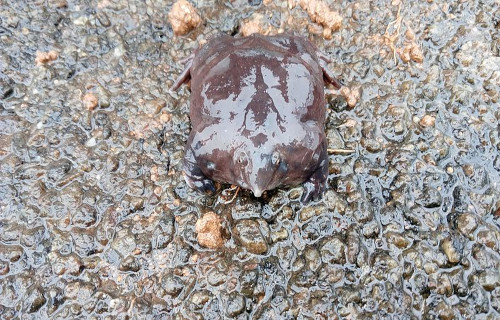
Purple Frog Facts
- Appearing next in this list of 7 Unbelievble Amphibians is the surprisingly hued species rightfully named the Purple Frog.
- Most notably, the remarkable creature easily ranks as one of the most unusual lesser known amphibians in the entire world. That holds true, in large part, to the very nature of its particular habitat.
- That’s because this fascinating amphibian actually spends the great majority of its life underground. While many related species also dwell underground, few do so as extensively as this creature.
- Quite sadly, this amazing animal now finds itself facing multiple threats to its continued existence. Because of this truly lamentable fact, the IUCN currently lists the brilliantly colored amphibian as Endangered.
- The threats the Purple Frog faces include the ongoing reduction and degradation of its already restricted range. Furthermore, the escalating effects of such factors as climate change also undermine its chances of survival.
Purple Frog Physical Description
First of all, while truly impressive in many respects, the Purple Frog nevertheless remains a physically small species. Furthermore, like numerous related species, it displays a marked degree of sexual dimorphism.
In its case, the males remain rather significantly smaller than the females. In fact, the larger females attain an average length of about 3.5 in (9 cm). Meanwhile, however, the males of the species rarely exceed 1.2 in (3 cm) in length.
In addition, both genders display a decidedly horizontally swollen looking body shape. As a result of this characteristic, the animal has an overall flattened body form. It also develops a relatively small head with a pointed snout.
However, its most remarkable physical feature remains its unique coloring. Adults of the Purple Frog typically display a darker grayish-purple color. But the majority of younger individuals often display a deep, bright purple color.
- Kingdom: Animalia
- Phylum: Chordata
- Class: Amphibia
- Order: Anura
- Family: Nasikabatrachidae
- Genus: Nasikabatrachus
- Species: N. sahyadrensis

Purple Frog Distribution, Habitat, and Ecology
Most notably, the amazing and reclusive Purple Frog inhabits a very specific portion of the world. This consists of the majority of the Western Ghats, in India, in Asia. However, even this represents an expansion of its previously supposes range.
Furthermore, it inhabits every habitat type within the mountain range. This occurs due to the simple fact that the amphibian lives virtually its entire life underground. There, it feeds on a variety of insects, with its diet predominantly consisting of termites.
In fact, the extremely reclusive animal only emerges from its underground habitat for a few days each year. This occurs during the annual monsoon season. That’s because, at that time, instinct drives the Purple Frog to the surface to mate.
Beyond these facts, however, researchers know very little of the biology of this species. Among the few facts known for certain is that males generally emerge near temporary streams formed by the torrential rains. After mating, eggs are laid in temporary pools, usually among rocks.
Wallace’s Flying Frog
Wallace’s Flying Frog Facts
- Wallace’s Flying Frog forms a remarkable type of Moss Frog. This animal bears the name of the biologist who identified it.
- This frog does not rank as the only known aerial amphibian, but it does constitute one of the largest.
- Perhaps a new expression should be coined: when frogs fly.
- The frog’s numbers remain undetermined because few people ever see them – which is rather unfortunate because the frog displays brilliant colors.
- Much uncertainty about whether man rarely sees the Wallace’s Flying Frog because of a scarcity of numbers or its natural timidity exists.

Wallace’s Flying Frog Physical Description
Most people generally consider the Wallace’s Flying Frog to be very photogenic. The frog’s colors are bright green on the back and either yellow or pale white on the underside.
Sexual dimorphism is displayed by this amphibian, with the males being somewhat smaller than the females. Females average about 3.9 in (10 cm) in length.
It possesses oversized webbed feet that it utilizes to glide from tree to tree. The eyes also grow quite large, with horizontal pupils.
The species also has big toe pads, which helps it cling to trees as it lands from its flight.
Kingdom: Animalia
Phylum: Chordata
Class: Amphibia
Order: Anura
Family: Rhacophoridae
Genus: Rhacophorus
Species: R. nigropalmatus
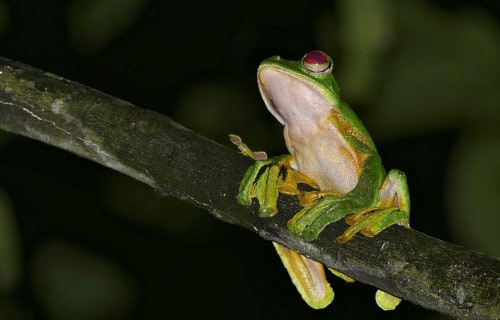
Wallace’s Flying Frog Distribution, Habitat, and Ecology
The incredible Wallace’s Flying Frog remains endemic to a habitat range extending from the Malay Peninsula to western Indonesia. It also only inhabits regions of the rainforest at altitudes of up to 1,970 ft (600 m).
Another habitat requirement is the local presence of either small pools of fresh water or slow-moving streams, required for breeding habits.
The animal spends the majority of its life in the trees, descending only to mate and lay eggs.
Its diet also consists entirely of a variety of small insects. Its only known natural predators are different arboreal snakes.
Limnonectes larvaepartus

Limnonectes larvaepartus Facts
- The recently discovered Limnonectes larvaepartus represents a unique species of frog. This newly recognized and rather remarkable animal species also does not yet possess a common name.
- Astonishingly, this incredible amphibian also represents one of only four known varieties of a frog to develop fang-like teeth.
- Out of the 6,455 extant species of frog known to science, this one also represents one of only twelve to reproduce internally.
- To add to its distinctiveness, the Limnonectes larvaepartus also serves as the only known frog on earth to not only conceive internally but to give birth to fully developed tadpoles.
- The other species of frogs to give birth to live young deliver froglets.
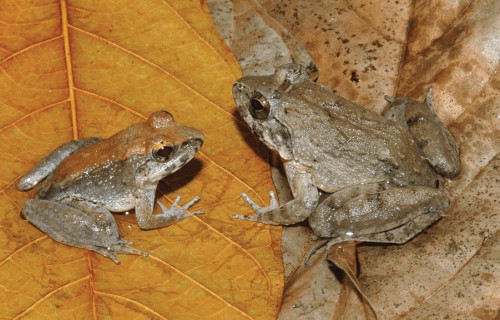
CCL: https://bit.ly/35URcUx
Limnonectes larvaepartus Physical Description
The surprising Limnonectes larvaepartus also displays a slight degree of sexual dimorphism. Overall, the species averages roughly 1.5 in (3.8 cm) in length.
However, females average slightly larger in length, whereas the males have a slightly stouter body shape. This lightweight species reaches only 0.18 oz (5 grams) in weight.
The upper portions of the body vary in color. This portion may be either brownish gray, golden tan or reddish-brown. The underbelly of the Limnonectes larvaepartus may be either cream-colored or yellowish.
Kingdom: Animalia
Phylum: Chordata
Class: Amphibia
Order: Anura
Family: Dicroglossidae
Genus: Limnonectes
Species: L. larvaepartus

Limnonectes larvaepartus Distribution, Habitat, and Ecology
The diminutive Limnonectes larvaepartus remains endemic only to the island of Sulawesi, Indonesia, in Asia. It also remains unclear if the creature ever possessed a more extensive range.
The habitat of the rather diminutive marvel consists of a rather dense jungle, typically near streams, located amid the mountainous regions of the island.
After mating, females typically produce approximately 100 eggs. How the surprising creature achieves internal reproduction further remains a complete mystery for herpetologists.
This occurs because the male possesses no discernible reproductive organ. Nature still holds many mysteries.
7 Unbelievable Amphibians
These 7 Unbelievable Amphibians represent only a handful of the amphibian species in the world. In addition to frogs and toads, which comprise the vast majority of the Class, others also classify as either salamanders or caecilians.
Sadly, these 7 Unbelievable Amphibians and their kin also often possess extreme sensitivity to changes in climate. Given the changes today, many of these species now find themselves facing the possibility of extinction. We must do all we can to prevent this tragedy.
Check out our other articles on 7 Stunning North American Lepidoptera, Scottish Wildcat, 10 Dazzling Denizens of the Depths
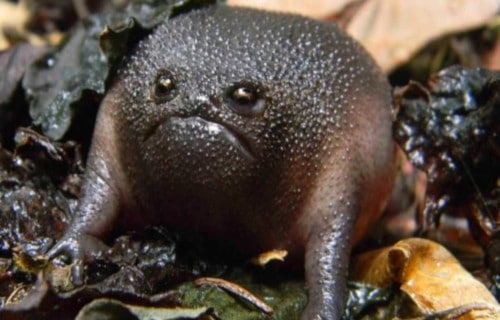
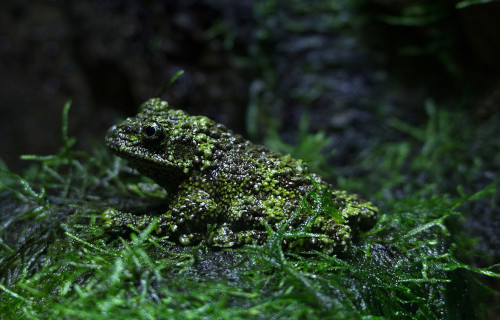

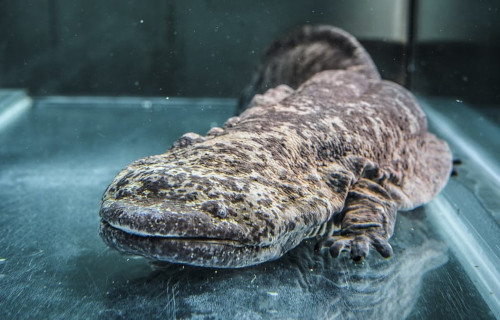
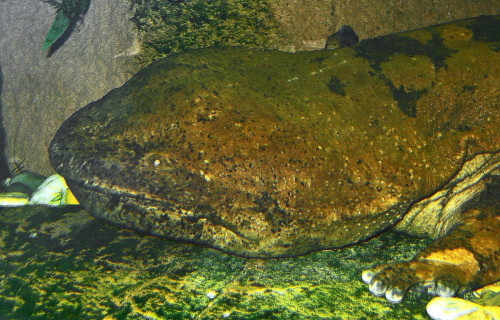
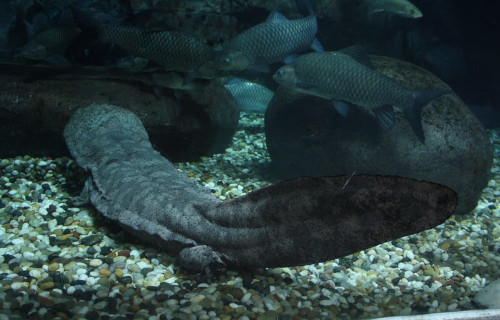
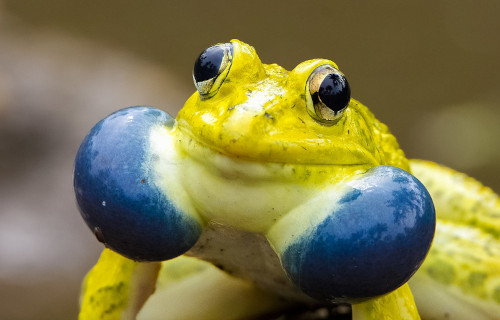

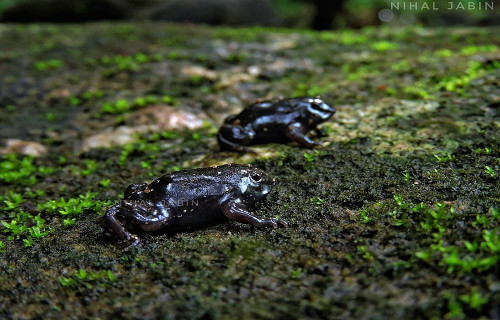










🐸